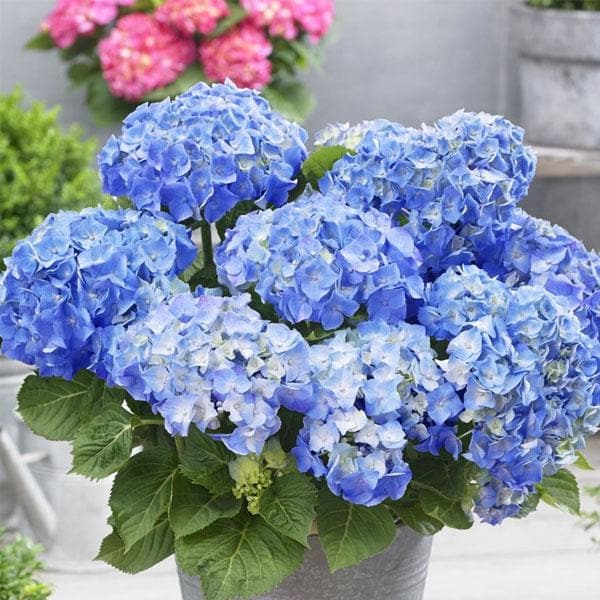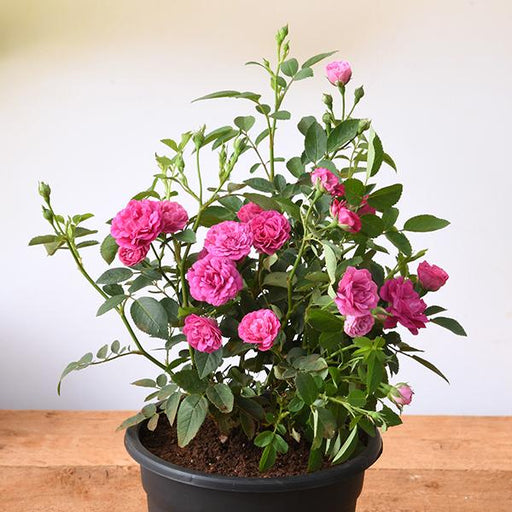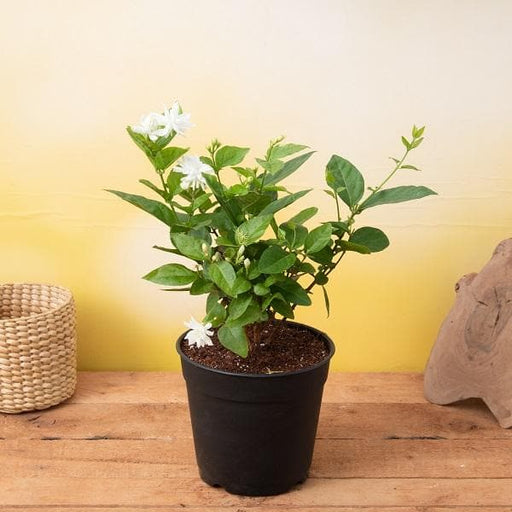
Hydrangea Macrophylla (Blue) - Plant
(MRP Inclusive of all taxes)
- Shipping ₹79 for entire order
- Dispatch in 7 days
- Country of origin: India

(MRP Inclusive of all taxes)
 Save 29%
Save 29%
Air Purifier Money Plant with Pot The Air Purifier Money Plant, also known as Pothos or Epipremnum aureum, is a stunning indoor plant that...
View full details
 Save up to 15%
Save up to 15%
Peace Lily, Spathiphyllum - Plant The Peace Lily, scientifically known as Spathiphyllum, is a stunning houseplant celebrated for its elegant white...
View full details
 Save 25%
Save 25%
Jasminum sambac, Mogra, Arabian Jasmine - Plant Jasminum sambac, commonly known as Mogra or Arabian Jasmine, is a fragrant flowering plant...
View full details
 Save 18%
Save 18%
Combo Constituents Includes the Parijat Tree (Night-Flowering Jasmine), a culturally significant plant with fragrant flowers. Description The Pari...
View full details
 Save 25%
Save 25%
Miniature Rose, Button Rose (Any Color) - Plant The Miniature Rose, also known as the Button Rose, is a charming and compact flowering plant that ...
View full details Save 25%
Save 25%
Damascus Rose, Scented Rose (Any Color) - Plant The Damascus Rose, also known as Rosa damascena, is a timeless symbol of beauty and romanc...
View full details
 Save 17%
Save 17%
Beautiful Fragrant Mogra, Arabian Jasmine Plant with Pot The Beautiful Fragrant Mogra, also known as Arabian Jasmine (Jasminum sambac), is...
View full details Save 15%
Save 15%
Pack of Vermicompost and Neem Cake for House Plants Transform your indoor garden with our premium Pack of Vermicompost and Neem Cake, spec...
View full details
Pack of Plant Growth and Flower Boosters Unlock the full potential of your garden with our Pack of Plant Growth and Flower Boosters! This ...
View full details Save 38%
Save 38%
Combo of Jeevamrut and Neem Raksha for Easy Growth and Protection of Houseplants Transform your indoor garden with our exclusive combo of ...
View full details Save 22%
Save 22%
Plant Nutrients Kit (Pack of 16) for a Healthy Garden Transform your garden into a lush paradise with our Plant Nutrients Kit, featuring 1...
View full details Save 16%
Save 16%
Combo of Top Plant Fertilizers Elevate your gardening game with our exclusive Combo of Top Plant Fertilizers, featuring two bags of premiu...
View full details Save 24%
Save 24%
Pack of 4 Additives to Make Soil Healthy and Nutrient Rich Transform your garden into a thriving ecosystem with our Pack of 4 Additives de...
View full details Save 30%
Save 30%
Transform your gardening experience with our premium Combo of Perlite and Vermiculite. This unique blend is designed to enhance soil aeration and ...
View full details Save 27%
Save 27%
Combo of 2 Vermicompost and Cocopeat - Enrich Your Soil Naturally! Transform your garden into a thriving ecosystem with our Combo of 2 Ver...
View full details
 Save 35%
Save 35%
Best 6 Plants for Perfect Indoor Garden Transform your living space into a lush oasis with our curated collection of the Best 6 Plants for a...
View full details
 Save up to 50%
Save up to 50%
Mini Succulent Garden Pack Transform your space with our Mini Succulent Garden Pack, featuring a delightful collection of 4 any variety beautiful s...
View full details
 Save 30%
Save 30%
5 Best Fragrant Plants Transform your garden or indoor space into a fragrant paradise with our curated selection of the 5 Best Fragrant Plants. Th...
View full details
 Save 24%
Save 24%
Set of 2 Bonsai Looking Grafted Adeniums Transform your indoor or outdoor space with our exquisite Set of 2 Bonsai Looking Grafted Adenium...
View full details Save 45%
Save 45%
Top 4 Die Hard Succulents Pack Transform your indoor or outdoor space with our Top 4 Die Hard Succulents Pack, featuring a curated selecti...
View full details
 Save 30%
Save 30%
5 Best Indoor Plants Pack Transform your living space into a lush oasis with our '5 Best Indoor Plants Pack.' This carefully curated collection fe...
View full details
 Save 25%
Save 25%
Set of 4 Evergreen Air Purifier Plant Pack Transform your indoor space into a lush, green oasis with our Set of 4 Evergreen Air Purifier Pla...
View full details| SrNo | Item Name | Qty |
|---|---|---|
| 1 | Hydrangea Macrophylla (Blue) Plant in 6 inch (15 cm) Pot | 1 |
The Hydrangea Macrophylla, commonly known as the Bigleaf Hydrangea, is a stunning flowering plant renowned for its vibrant blue blooms. This deciduous shrub thrives in temperate climates and is a favorite among gardeners for its lush foliage and abundant flowers. With its ability to change color based on soil pH, it offers a unique opportunity to create a personalized garden aesthetic.
What makes the Hydrangea Macrophylla special is its adaptability and stunning visual appeal. The blue hue of its flowers is a result of aluminum ions in acidic soils, making it a fascinating subject for garden enthusiasts. This plant not only enhances the beauty of any landscape but also attracts pollinators, contributing positively to the local ecosystem.
Special features of the Hydrangea Macrophylla include its long blooming season, typically from late spring to early fall, and its ability to thrive in partial shade. This makes it an excellent choice for gardens with varying light conditions. Additionally, its large, lush leaves provide a beautiful backdrop for the vibrant blooms, creating a stunning visual display.
Caring for your Hydrangea Macrophylla is like nurturing a diva; it requires just the right amount of attention, water, and sunlight. These beauties thrive in well-drained soil and prefer a bit of shade to keep their vibrant blue hues intact. Remember, too much sun can lead to wilting, and nobody wants a sad plant. Regular pruning will keep your hydrangea looking fabulous, so don’t be shy—give those branches a snip!
Think of Hydrangea Macrophylla as a plant with a refined palate; it craves slightly acidic soil to bring out its stunning blue color. Aim for a pH between 5.5 and 6.5, and your hydrangea will reward you with blooms that make your neighbors green with envy. If your soil is too alkaline, consider adding some sulfur or peat moss to spice things up.
When it comes to feeding your Hydrangea Macrophylla, think of it as a gourmet meal. A balanced fertilizer in early spring will set the stage for a blooming extravaganza. Look for a formula high in potassium to enhance those luscious blue flowers. Just remember, overfeeding can lead to a plant that’s all show and no substance, so stick to the recommended dosage!
Pruning your Hydrangea Macrophylla is like giving it a stylish haircut. The best time to do this is in late winter or early spring before new growth begins. Snip away dead or weak stems to encourage fresh blooms, but don’t go overboard—leave some old wood for next year’s flowers. A well-pruned hydrangea is a happy hydrangea, ready to flaunt its colors!
Want to multiply your Hydrangea Macrophylla collection? Propagation is the way to go! You can take cuttings in late spring or early summer and root them in water or soil. It’s like cloning your favorite plant, but without the sci-fi drama. Just be patient, and soon you’ll have a mini hydrangea army ready to take over your garden!
Hydrangea Macrophylla is a bit of a sunbather, but it prefers dappled sunlight over harsh rays. Aim for about four to six hours of indirect sunlight daily, and your plant will be as happy as a clam. Too much direct sun can scorch those beautiful leaves, while too little can lead to a lackluster bloom. It’s all about finding that perfect balance!
Watering your Hydrangea Macrophylla is like giving it a refreshing drink after a long day. These plants love moisture, so keep the soil consistently damp but not soggy. A good rule of thumb is to water deeply once a week, especially during hot spells. Just remember, nobody likes a thirsty plant, so don’t let it dry out!
The color of your Hydrangea Macrophylla blooms can be a delightful surprise, ranging from soft blues to vibrant purples. The secret lies in the soil pH; acidic soils yield blue flowers, while alkaline soils produce pink. It’s like a mood ring for plants! So, if you’re feeling adventurous, play with soil amendments to change up the color palette in your garden.
Like any diva, Hydrangea Macrophylla can be prone to a few ailments. Watch out for powdery mildew and root rot, which can dampen its spirits. Good air circulation and proper watering practices can help keep these pesky issues at bay. If you spot any signs of trouble, act fast—your hydrangea deserves a healthy life!
Pairing your Hydrangea Macrophylla with the right companions can create a garden masterpiece. Consider planting alongside ferns, hostas, or astilbes for a lush, layered look. These plants not only complement the hydrangea’s beauty but also share similar care requirements. It’s like hosting a garden party where everyone gets along!
Seasonal care for your Hydrangea Macrophylla is like preparing for a yearly festival. In spring, focus on pruning and fertilizing; in summer, keep up with watering; in fall, deadhead spent blooms; and in winter, protect the roots with mulch. Each season brings its own tasks, but with a little effort, your hydrangea will be the star of the show all year round!
Hydrangea Macrophylla (Blue) is the diva of the garden world, flaunting stunning blue blooms that can make any flower blush. This deciduous shrub thrives in partial shade and loves moist, well-drained soil. With its big, bold flowers, it’s like the garden’s version of a blue ribbon winner!
Caring for Hydrangea Macrophylla (Blue) is like nurturing a high-maintenance friend. Keep the soil consistently moist, provide some shade, and don’t forget to prune after blooming. A little fertilizer in spring will keep it happy, but avoid overdoing it—too much love can lead to a wilting relationship!
If your Hydrangea Macrophylla (Blue) is throwing a pink party, it’s likely due to soil pH. A higher pH (alkaline) can turn those blue beauties pink. To keep them blue, add aluminum sulfate to the soil. It’s like giving your plant a makeover—just make sure it’s the right shade!
These floral showstoppers typically bloom from late spring to early fall, giving you a long-lasting display of blue brilliance. Think of them as the garden’s summer blockbuster, captivating audiences with their vibrant colors and lush foliage. Just be sure to give them the spotlight they deserve!
Propagating Hydrangea Macrophylla (Blue) is like playing matchmaker with cuttings. Take a 4-6 inch cutting in late spring, dip it in rooting hormone, and plant it in moist soil. Keep it warm and humid, and soon you’ll have a mini version of your favorite blue shrub ready to shine!
While Hydrangea Macrophylla (Blue) enjoys a bit of sunshine, full sun can be a bit too much. Think of it as a sunbather who prefers a shady umbrella. Ideally, it thrives in partial shade, where it can soak up some rays without getting scorched. Balance is key!
Hydrangea Macrophylla (Blue) prefers well-drained, rich, and slightly acidic soil. It’s like a gourmet meal for your plant—nutrient-rich and perfectly balanced. If your soil is too alkaline, those blue blooms might just turn pink. So, keep it acidic, and your hydrangea will be the belle of the ball!
Watering Hydrangea Macrophylla (Blue) is like keeping a pet goldfish—too little and it’s sad, too much and it’s drowning! Aim for consistent moisture, especially during hot spells. A good rule of thumb is to check the top inch of soil; if it’s dry, it’s time for a drink!
Watch out for pesky pests like aphids and spider mites that might want to crash your hydrangea party. They can sap the life out of your plant faster than a bad date. Regularly inspect your blooms and use insecticidal soap if needed. Keep your hydrangea pest-free and fabulous!
Absolutely! Growing Hydrangea Macrophylla (Blue) in a pot is like giving it a VIP pass to your patio. Just ensure the pot has good drainage and use quality potting mix. Remember to water regularly and provide some shade. Your potted hydrangea will be the talk of the town!
Pruning Hydrangea Macrophylla (Blue) is like giving it a stylish haircut. Do it right after blooming to avoid cutting off next year’s flowers. Trim back dead or weak stems and shape it to your liking. Just remember, a little snip here and there can keep your hydrangea looking fabulous!
If your Hydrangea Macrophylla (Blue) is playing hard to get, it might be due to insufficient sunlight, improper pruning, or nutrient issues. Check its location and care routine. Sometimes, it just needs a little encouragement—like a pep talk or a sprinkle of fertilizer—to get those blooms popping!